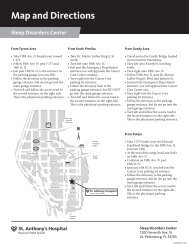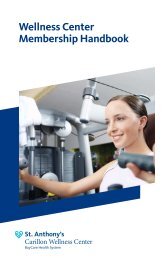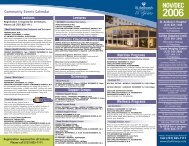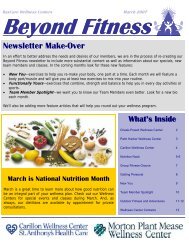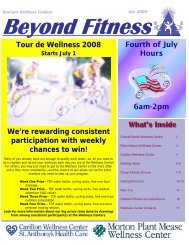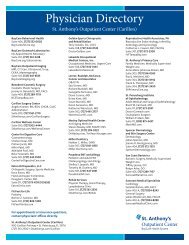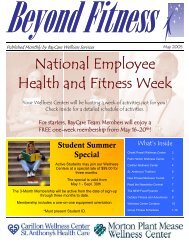2008 winter - Blueprint for Health magazine - St. Anthony's Hospital
2008 winter - Blueprint for Health magazine - St. Anthony's Hospital
2008 winter - Blueprint for Health magazine - St. Anthony's Hospital
Create successful ePaper yourself
Turn your PDF publications into a flip-book with our unique Google optimized e-Paper software.
Managing Medicines:<br />
How to <strong>St</strong>ay Safe During<br />
Cold and Flu Season<br />
Cold and flu season is<br />
upon us! To relieve<br />
symptoms, many people<br />
count on products such as Tylenol,<br />
Panadol and Feverall — all<br />
of which contain the medicine<br />
“acetaminophen.” As with all<br />
kinds of medicine, it’s important<br />
to keep safety in mind whenever<br />
you take this common drug.<br />
FOLLOW RECOMMENDED DOSES<br />
Acetaminophen is used to relieve<br />
mild to moderate pain and to<br />
reduce fever. When used properly,<br />
it can be safe and effective. But<br />
overdoses can be fatal. And, taking<br />
low doses of acetaminophen<br />
every day <strong>for</strong> several months can<br />
cause serious liver and kidney<br />
problems. To be safe, always<br />
follow the instructions on your<br />
medicine’s label and never exceed<br />
the recommended daily dose.<br />
AVOID AN OVERDOSE<br />
Accidental overdoses of acetaminophen<br />
can occur when<br />
people do not realize that a<br />
medicine they are taking contains<br />
acetaminophen or that they<br />
have taken two or more products<br />
containing acetaminophen at the<br />
same time.<br />
To stay safe, follow the<br />
recommended dose: 1,000 mg of<br />
acetaminophen every 6 hours, <strong>for</strong><br />
a total of 4 grams per day. If you<br />
have kidney or liver problems,<br />
ask your doctor or pharmacist<br />
what’s right <strong>for</strong> you.<br />
SAFETY TIPS<br />
To make it through cold and flu<br />
season safely, follow these tips:<br />
• Always read labels. The chart<br />
to the right shows examples of<br />
common medicines that contain<br />
acetaminophen.<br />
• Ask your doctor or pharmacist<br />
about the ingredients in your<br />
prescriptions and whether your<br />
prescriptions could interact with<br />
your cold or flu medicine.<br />
• If acetaminophen doesn’t<br />
improve your symptoms, don’t take<br />
more. Instead, consult your doctor.<br />
• Remember to provide a<br />
complete list of all medications<br />
you are taking to all of your<br />
health care providers.<br />
• Get a flu shot each fall. •<br />
Examples of Prescription Products<br />
Containing Acetaminophen:<br />
Acetaminophen<br />
Product Name<br />
per Tablet/Capsule<br />
Vicodin, Esgic Plus, Lortab, Tylox, Percocet<br />
7.5/500, Endocet 7.5/500, Roxicet<br />
Darvocet-N 100, Percocet 10/650,<br />
Endocet 10/650, Lorcet Plus<br />
Vicodin HP<br />
Vicodin ES<br />
500 mg<br />
650 mg<br />
660 mg<br />
750 mg<br />
Examples of Over-the-Counter<br />
Products Containing Acetaminophen:<br />
Product Name<br />
Actifed Cold & Sinus Maximum<br />
<strong>St</strong>rength, Midol Pre-Menstrual Syndrome,<br />
Excedrin Tension Headache,<br />
Tylenol PM Extra <strong>St</strong>rength<br />
TheraFlu Daytime Severe Cold Hot<br />
Liquid<br />
TheraFlu Flu & Chest Liquid<br />
Acetaminophen<br />
per Tablet/Capsule<br />
500 mg<br />
650 mg<br />
(per packet)<br />
1,000 mg<br />
(per packet)<br />
ECHINACEA: CURE-ALL FOR THE COMMON COLD?<br />
Some studies show that echinacea can<br />
reduce the length and severity of a<br />
cold. But one study says this popular<br />
herb may have no effect on a cold —<br />
or its symptoms.<br />
About 70 college-aged women and<br />
men agreed to take an echinacea<br />
supplement. The participants took six<br />
1-gram doses of the herb on the first<br />
day cold symptoms appeared. Then,<br />
they took three 1-gram doses per day<br />
<strong>for</strong> up to 10 days. Another group of<br />
about 70 young adults followed this<br />
exact pattern, but used a placebo<br />
instead.<br />
Both groups had colds <strong>for</strong> the same<br />
length of time: about two to 10 days.<br />
There also was no difference in the<br />
severity of their cold symptoms.<br />
The researchers concluded that the<br />
dried mixture of unrefined echinacea<br />
they tested had no benefits. However,<br />
they also noted that another echinacea<br />
preparation may have different<br />
results — and further studies of the<br />
herb are needed.<br />
Annals of Internal Medicine, Vol. 137, No. 12<br />
<strong>Blueprint</strong> <strong>for</strong> <strong>Health</strong> | Winter <strong>2008</strong><br />
3



